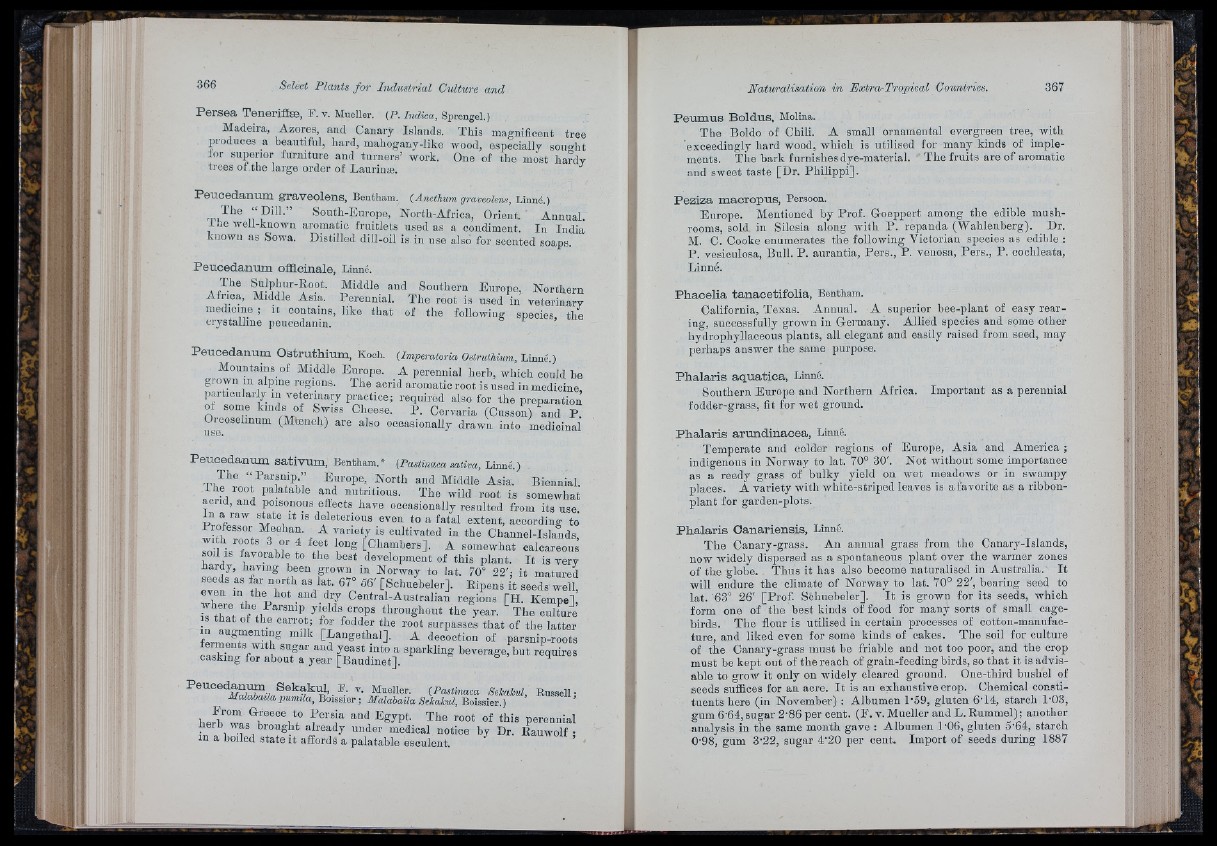
Persea Teneriflæ, F. v. Mueller. (P. indica, Sprengel.)
Madeira, Azores, and Canary Islands. This magnificent tree
produces a beautiful, hard, mahogany-like wood, especially sono-ht
tor superior furniture and turners’ work. One of the most hardy
trees of the large order of Lauriuæ.
Peucedanum graveolens, Bentham. (Ancthum graveolens, Lhmé.)
South-Europe, North-Afriea, Orient. Annnal.
I he well-known aromatic fruitlets used as a condiment. In India
known as Sowa. Distilled dill-oil is iu use also for scented soaps.
Peucedanum offloinale, Linné.
‘‘“ J Southern Europe, Northern
Africa, Middle Asia. Perennial. The root is used in veterinary
medicine ; it contains, like th a t of the following species the
erystalime peucedanin.
Peucedanum Ostruthium, Kooh. (Impcratoria Ostruthium, Linné )
Mountains of Middle Europe. A perennial herb, which could be
gi own in alpme regions. The acrid aromatic root is used in medicine,
limticularly in veterinary practice; required also for the preparation
m some kmds of Svdss Cheese. P. Cervaria (Ciisson) and P .
Oieoselmiim (Moeucli) are also occasionally drawn into medicinal
11S6.
Peucedanum sativum, Bentham.» (Pastinaca sativa, Linné.)
The “ Parsnip ” Europe, North and Middle Asia. Biennial,
i h e root palatable and nutritious. The wild root is somewhat
acrid, and poisonous effects have occasionally resulted from its use.
Ill a raw state it is deleterious oven to a fatal extent, according to
Professor Meehan. A variety is cultivated in the Channel-Islands,
w th loots 3 or 4 feet long [Chambers]. A somewhat calcareous
soil is favorable to tlie best development of this plant. I t is very
hardy, having been grown in Norway to lat. 70° 22'; it matured
seeds as far north as lat. 67° 56' [Schuebeler], Ripens it seeds well,
whm-e“ tl P Central-Australian regions [H . Kempe],
R that *f® Farsmp yields crops throughout the year. The culture
is that of the carrot; for fodder the root surpasses that of the latter
“ [Langethal]. A decoction of parsnip-roots
meats with sugar and yeast into a sparkling beverage, but requires
casking for about a year [Baudinet]. equues
Peucedanim Sekakul,_F. v. Mueller. (Pastinaca Sehahul, Bussell;
Malabaila pumila, Boissier ; Malabaila Sclcakul, Boissier.)
^ sy p t. The root of this perennial
herb was brought already under medical notice by Dr. Eauwolf ;
in a boiled state it affords a palatable esculent
P e u m u s B o ld u s , Molina.
The Boldo of Chili. A small ornamental evergreen tree, with
exceedingly hard wood, which is utilised for many kinds of implements.
'The hark furnislies dye-material. The fruits are of aromatic
and sweet taste [Dr. Philippi].
P e z iz a m a c r o p u s , Persoon.
Europe. Mentioned by Prof. Goeppert among the edible mushrooms,
sold in Silesia along with P . repanda (Wahlenberg). Dr.
M. C. Cooke enumerates the following Victorian species as edible :
P . vesiculosa, Bull. P. aiirantia, Pers., P. venosa, Pers., P. eochleata,
Linné.
P h a c e l i a t a n a c e t if o l i a , Bentham.
California,'Texas. Annual. A superior bee-plant of easy rearing,
successfully grown in Germany. Allied species and some other
hydrophyllaceous plants, all elegant and easily raised from seed, may
perhaps answer the same purpose.
P h a l a r i s a q u a t i c a , Linné.
Southern Europe and Northern Africa,
fodder-grass, fit for wet ground.
Important as a perennial
P h a l a r i s a r u n d in a c e a , Linné.
Temperate and colder regions of Europe, Asia and America ;
indigenous in Norway to lat. 70° 30'. Not without some importance
as a reedy grass of bulky yield on wet meadows or in swampy
places. A variety with white-striped leaves is a favorite as a ribbon-
plant for garden-plots.
P h a l a r i s C a n a rie n ffis , Linné.
The Canary-grass. An annual grass from the Canary-Islands,
now widely dispersed as a spontaneous plant over the warmer zones
of the globe. Thus it has also become naturalised in Australia. I t
will endure the climate of Norway to lat. 70° 22', bearing seed to
lat. 63° 26' [Prof. Schuebeler]. I t is grown for its seeds, which
form one of the best kinds of food for many sorts of small cage-
birds. The flour is utilised in certain processes of cotton-manufac-
ture, and liked even for some kinds of cakes. The soil for culture
of the Canary-grass must be friable and not too poor, aud the crop
must be kept out of the reach of grain-feeding birds, so th a t it is advisable
to grow it only on widely cleared ground. One-third bushel of
seeds suffices for an acre. I t is an exhaustive crop. Chemical constituents
here (in November) : Albumen P59, gluten 6T4, starch 1-03,
gum 6-64,sugar 2-86 per cent. (F .v . Mueller and L. Rummel); another
analysis in the same month gave : Albumen 1'06, gluten 5'64, starch
0-98, gum 3-22, sugar 4‘20 per cent. Import of seeds during 1887